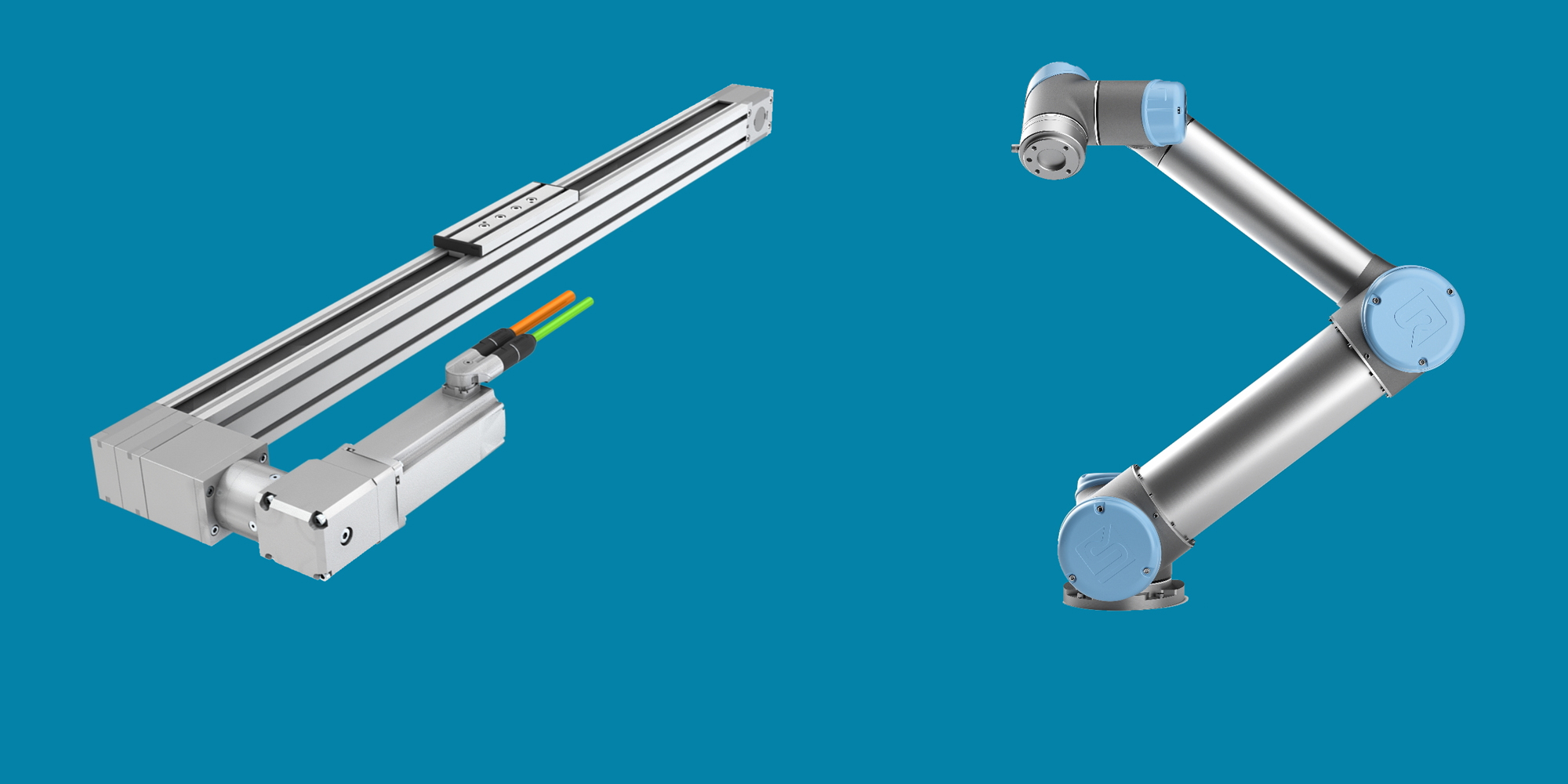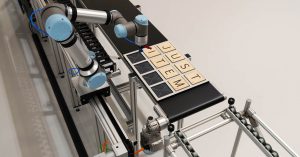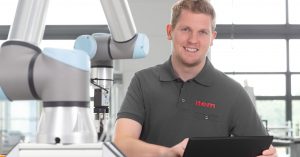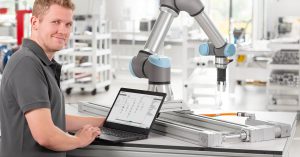Our decision-making guide will show you which form of automation is better suited to specific tasks.
There are currently numerous challenges facing industry – everything from compromised supply chains as a result of the coronavirus pandemic and the war in Ukraine to the increasing shortage of skilled workers. How can these issues be tackled effectively? A recent study by ABB that interviewed executives in Germany and other European countries offers some enlightening insights. The results found that 84 percent of the German and 74 percent of the European companies plan to invest in robotics and automation in the future – as the basis of reshoring or nearshoring measures. The underlying aim is to become more resilient in the face of the current global situation. Martin Ruskowski from the German Research Centre for Artificial Intelligence (DFKI), who also deals with this topic, has taken a look at all sectors and is in no doubt that the shortage of skilled workers is playing a significant role: “Look at the technical and demographic development in many industrialised nations. Only the economies capable of quickly implementing digitalisation and automation will survive in this market.” Indeed, automation is playing a key role right now. But which form of automation – robotics or linear technology – is better suited to what? When is it worth combining the two? Either way, item offers the ideal solution, thanks to its building kit philosophy.
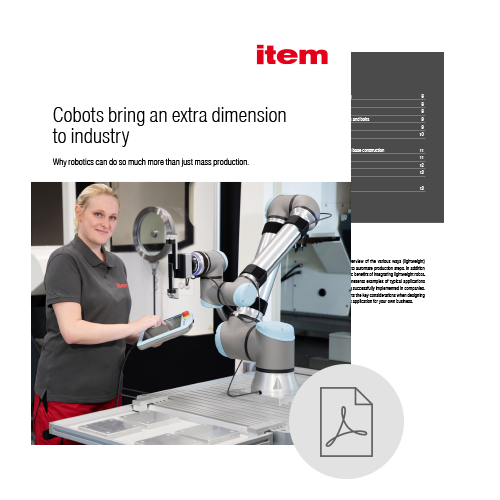
An overview of robot applications
Read our white paper to discover specific applications and other advantages of robotics in industry – and explore why lightweight robotics is a particularly worthwhile investment for small and medium-sized enterprises.
GET YOUR COPY NOW!
Linear technology – ideal for clearly defined, rapid and frequently repeated processes
Linear technology is an integral part of process automation. It is always used in production processes that involve fast and precise movements along a path, high positioning accuracy or the movement of heavy loads. Its underlying concept is based on movable carriages that travel along a linear route on a support profile. However, that is certainly not all linear technology has to offer. For example, projects that require movement in two or three dimensions can also be implemented by combining multiple linear units. The item linear system can be used to build single-axis linear units, 2D gantries and 3D gantries. The numerous components of this building kit system can help carry out a whole range of automation processes. In addition to linear guides, carriages, drives and controllers, item also offers preconfigured linear units and turnkey solutions.
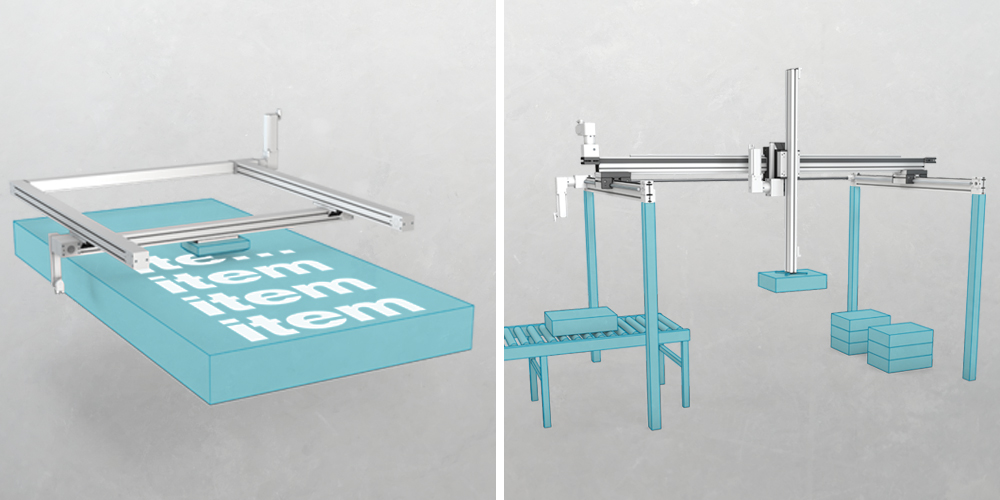
Typical, tried-and-tested applications for linear technology
In production, single-axis linear units are often used when tools need to be moved along a straight line. This is the case with drilling or screwing, for example. Not only that, but heavy loads can be easily moved using single-axis linear units. Synchronised linear axes are used in more complex applications. The synchronisation allows for the production of multi-axis systems (= gantries), thus forming the basis for multi-dimensional applications. In 2D gantries, for example, nozzles, pushbuttons, sensors or scanners are guided through a plane.
Whether it’s a single-axis, two-dimensional or three-dimensional application – solutions featuring linear technology allow for optimum positioning accuracy and rapid movements.
XY tables are ideal for moving heavy tools and performing sorting or filling processes. Material and load tests can be carried out using cantilever axes. Linear technology components also open the door to three-dimensional processes, such as stacking, palletising and various sorting tasks. Whether it’s a single-axis, two-dimensional or three-dimensional application – solutions featuring linear technology allow for optimum positioning accuracy and rapid movements. Other advantages of this technology include straightforward commissioning, a long service life, low maintenance requirements, low investment costs and simple programming. Nowadays, prior PLC knowledge is no longer required for simple or moderately complex applications – the item building kit system for linear technology and the corresponding software make it all possible.

Benefit from outstanding flexibility by automating with robotics
Thanks to their lightweight design, cobots (collaborative robots) can be used in a wide variety of spaces. In addition to being easy to integrate, they can be equipped with a large number of end effectors, which gives them a wide range of possible uses. End effectors are tools that attach to the end of the robotic arm and can be easily swapped out. This means cobots are suitable for tasks as diverse as screwing and welding, assembling and sorting, and palletising and machine loading. They’re able to carry out these tasks tirelessly and with the utmost precision. What’s more, cobots make it much easier to get started with robot-assisted automation because they’re so easy to program. With the help of a graphical user interface, simple work steps can be defined using a touch display, even without any programming experience.
Thanks to their versatility, easy implementation and simple and safe handling, cobots are becoming increasingly popular.
As the name suggests, cobots are, generally speaking, designed to collaborate directly with humans. They are not intended to replace them, but rather take over the burden of repetitive, strenuous and unergonomic tasks. Guards and other protective enclosures are often not required because cobots are designed to work closely with people. For example, cobots have integrated sensors that bring them to a halt when they come into contact with a person or, when combined with external area scanners, immediately interrupt the ongoing process as soon as someone approaches. In practice, however, fully collaborative applications, where humans and cobots really work hand in hand, are rather rare. The general rule is that cobots are used for the purposes of partial automation or sporadic collaboration. For example, a human prepares the process and then leaves the cobot to do the work. However, this does not mean cobots are any less successful – quite the opposite. Thanks to their versatility, easy implementation, and simple and safe handling, cobots are becoming increasingly popular. In 2021, the cobot market grew by 40 percent. According to a forecast by the market research firm Interact Analysis, it will be worth over 2 billion dollars by 2026.
Implement highly versatile cobot solutions with item
To integrate cobots, you need to have the right components. The modular building kit system for cobot solutions from item offers almost unlimited possibilities in this regard. The right robot solution can be implemented for any specific requirement. In a partially enclosed cobot cabin, for example, the robotic arm can use the entire working surface, while workers are protected by the removable cover, which means the robot can operate at a higher speed outside the collaborative area. The large, impact-resistant windows ensure staff can monitor the working process at all times. All cables run through the integrated cable ducts of the Line XMS profiles , which keeps them protected. Special Fastening Sets are used to form cable entry points between vertical and horizontal profiles. This makes separating the levels particularly simple.
The robot column for mobile cobot use is particularly fast and manoeuvrable. Even large cobot models can get from A to B with the help of this stable frame.
Mobile solutions such as the robot island with integrated under-bench cabinet are ideal for applications that involve switching between workstations. Thanks to the Groove Plate on the top, the cobot can be positioned and aligned as required. The Line XMS profiles are used for cable management, with all the cables running through the cable conduits, which can be accessed from the outside, while control elements can also be easily integrated. The controller is housed in the closed supply section. The robot column for mobile cobot use is particularly compact and manoeuvrable. Even large cobot models can get from A to B with the help of this stable frame. The central column offers ample space to attach the robot arm. At the workstation, the cobot is kept securely in place with the help of Jacking Castors. The column, base and fixtures and fittings can be modified and scaled as needed.
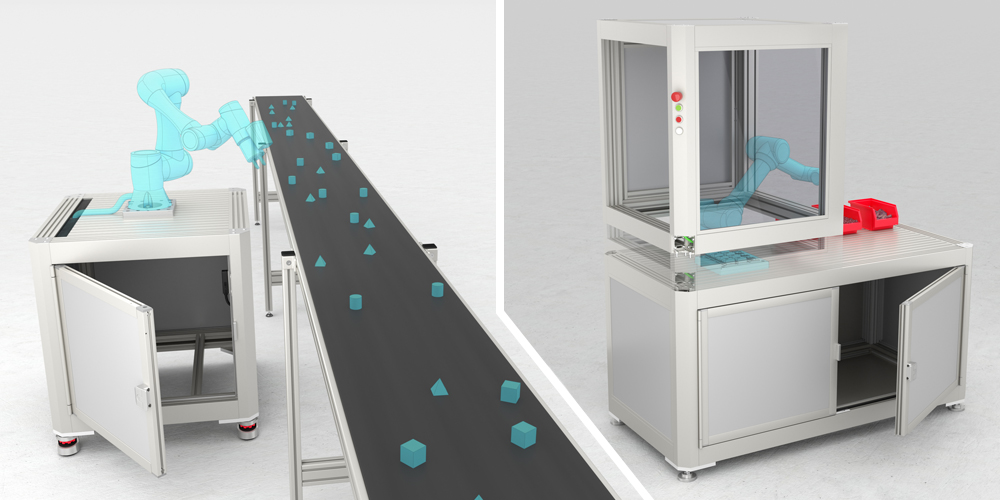
Think of robotics and linear technology as more than mere alternatives
There are also cases where it’s worth combining linear technology and robotics. In many production lines, raw parts are still fed in manually, for example. Combining linear technology and robotics significantly increases efficiency when it comes to assembly and even material handling. For example, a robot can be mounted onto a linear unit so it can be moved from one production area to another. The linear axis is used as a range extender for the robot to increase its radius of movement. Combining both technologies also offers considerable advantages for pick-and-place tasks – in other words, processes where objects are picked up and set down again at a different location.
The “Flying Saw” student project is a shining example of the many combinations made possible by the modular design of the item building kit system.
The “Flying Saw” student project shows just how well robotics and linear technology can complement each other. The students placed a cobot on an item linear unit that runs in sync with a belt conveyor from the item conveyor belt system. Puzzle pieces on the moving conveyor belt are rearranged by the cobot, which, thanks to the linear technology, has a seventh axis. A roller conveyor is connected to this structure for the onward transport of the workpieces. This is a shining example of the many combinations made possible by the modular design of the item building kit system. In addition, systems can be implemented in which the robot carries out its tasks while suspended from a linear unit. This makes it possible to carry out both conventional welding work as well as gripping and sorting tasks on a production line. This is where the special advantages of linear technology come into play. There is no limit to how long the linear axes can be, and linear units can also be configured to suit each specific task.
When a robot is attached to a single-axis linear unit, it can be moved quickly and precisely from one station to another.
The focus should always be on people
However, not only does combining robotics and linear technology help boost efficiency – it also leads to potential savings. For example, several robots on a production line can be replaced by a single one that is automatically transported from station to station on a linear axis to carry out various work steps. Success can only be achieved if people and technology work together seamlessly – and this applies to all these projects. After all, the goal is not to replace humans. Instead, it’s about creating an infrastructure that takes the strain off employees, organizes work processes more effectively and makes processes more efficient. Whether it’s with linear technology, robotics or a combination of both – the perfect technical basis can be created with the modular automation components from item.
Would you like to learn more about the world of linear technology and robotics? Simply subscribe to the item blog by completing the box at the top right.

